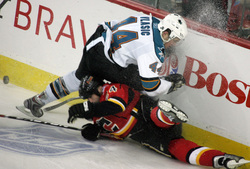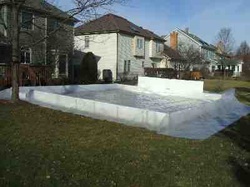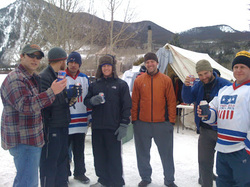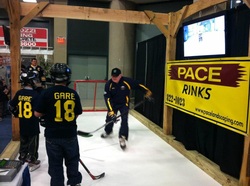 A majority of Americans have suffered from the Cinderella story of Florida Gulf Coast in the NCAA mens basketball tournament. The real March Madness is the Frozen Four for us hockey fans, however, and we wanted to give our fans a way to get even more involved in the action while giving your bracketology skills a second shot. Go to http://www.timhortonsbackyardclassic.com/frozen-four-bracket-challenge.html to enter your bracket by Friday at 1:59 pm by emailing it to [email protected]. It is 100% free!
1 Comment
 All too often in the NHL have players been hurt on icing plays where a defenseman and forward are skating stride for stride at full capacity in order to touch the puck before the other. The onus lies on the forward who could absolutely punish the d-man into the boards behind the goal line. The NHL has done a good job in enforcing this safety issue and has led to still good competition for the puck behind the goal line on touch icings but still the issue remains for that one case. On the other hand skaters having to go back and touch the puck to get a whistle wastes valuable seconds off the clock and is essentially a waste of what could be almost half a minute of play during a game that spectators who are paying large sums of money are essentially seeing nothing happen. Lets look at the different types of icing. Keep in mind these are simple definitions and there are circumstances when an icing can be waved off by the linesman. Touch Icing: The defending player must touch the puck before any opposing player to complete the icing call. In place in the NHL and AHL. Hybrid Icing: Play is stopped immediately if the player on the opposing team reaches the faceoff dot first, instead of skating all the way across the goal line to touch the puck. In place in the NCAA. Automatic Icing: Play is blown dead immediately once the puck crosses the goal line. In place in USA Hockey. I believe that the NHL needs to go to hybrid icing just as the Minnesota Wild GM Chuck Fletcher suggests. If you need a reason why check out the video below of Kurtis Foster breaking his femur on a touch icing play. Add a comment below to agree or disagree. "In our backyard we have amazing youth hockey teams who are playing on a national level and you can watch for free!"  Why are we willing to shell out hundreds of dollars, sit in an hour of traffic pre and post-game, while spending $15 on beer and concessions watching the Sabres lose? Yet, literally in our backyard we have amazing youth hockey teams who are playing on a national level and you can watch often for free or under $10! Between the Buffalo Jr. Sabres teams to the Amherst Youth Hockey teams playing at the Northtown Center, four-rink facility in Amherst, NY, which hosts USA Hockey Nationals for multiple age levels every year; there is no reason to only pay to see the pros. Now don't get me wrong, I love going to a Sabres game at least once a year because it's a great atmosphere when you're spending time with 19,070 other people who share at least one thing in common with you, a love for Buffalo sports. Coming from the referee perspective, I believe youth hockey has been revolutionized with USA Hockey's initiatives. In an attempt to better the game, in my opinion, they have lessened the quality of talent at a local level as compared to Hockey Canada. It is a different style of play up in the Great White North and it often trumps the USA Hockey talent. Yet don't let this turn you off because the United States is churning out young players like never before. And its not just boys playing hockey anymore, the girls game is rapidly growing as well! Next time you want to go to watch a hockey game, avoid yourself the financial troubles and other difficulties associated with seeing a professional sports game and give youth sports a chance! Especially at the Nationals level you won't regret it!  With the couple days of warm weather which turned our ice rink into a swimming pool; some of you might have been smart enough to take out your plastic. But for those of you that stuck it out, Bravo! You may have been rewarded with a couple more skating days as the temperatures are staying low during the nighttime. However, with my time constraints I settled for taking the plastic from our Backyard Classic Rinks after ice had once again settled on top of our couple inches of water. This makes for a nightmare! Lesson to be learned here: wait until the ice is completely gone, if possible, because even a thin layer of ice can accumulate during removal and make the plastic a 100 or more lb sheet. Unfortunately, in my case, we had to get it out to prepare for flag football leagues and it took me two and a half hours just to remove the plastic (granted I was by myself). And ALWAYS remember to check the slope of your land to see where the water will drain!!  A concussion can have a devastating effect on a child's or teenagers life essentially bringing everything in their life to a halt. They can't go to school, watch tv, read a book, or socialize all because another player cheap-shotted him or her from behind into the boards head first. They never saw it coming and couldn't protect themselves. USA Hockey has tried to limit this issue by moving the checking age up to 14 year olds and up in order to limit the discrepancy in height and weight between teenagers experiencing puberty. This rule change is in an effort to maximize the skill plays and limit the fear of being hit on the blindside. But the problem isn't limited to youth hockey. It seems everyday another NHL player is being suspended whether it be a repeat offender in Patrick Kaleta or high-skill player of Corey Perry. The respect is no longer there and if we keep going the direction we are, USA hockey players are going to fall behind. It needs to start from the top and involve a full-scale remodel of the game of hockey. Hey maybe we just need to play the game out on the pond or backyard ice rink where there is no checking and all issues are resolved over a beer. The game is self-regulated with penalty shots and the focus is on having fun not necessarily keeping track of a score (even though everyone loves to beat their buddies). (ARTICLE COURTESY OF BACKYARD-HOCKEY.COM)
You’ll have to trust me on this one, but I’m writing this with a scowl. While everyone else is giddy with anticipation over the approaching warmth, we rinkbuilders are left with the saddest of sights: our new home-made reflecting pools. It was only weeks ago that these pools were host rinks for family parties, neighborhood get-togethers, and intimate one-on-ones between fathers and sons. Now? They’re the world’s largest bird baths. Scowl. Not unlike death and taxes, springtime is something we must deal with each year. We don’t necessarily have to enjoy it, but we do have to face it. And I’m here to help. (A caveat: this is absolutely one of those “do as I say, not as I do” posts. I once left my entire rink in place, only taking the time to slice up the liner, for an entire summer. The mosquitoes loved me, my wife hated me. I would not recommend.) What we’ll talk about today are the essentials of the rinkbuilder’s springtime to-do list: the drainage, the teardown, and the storage of your backyard rink. Let’s start with the obvious. Drainage The godfather of backyard rinks, Jack Falla, had a saying: “water seeking its own level will find it in your neighbor’s yard.” He learned this while attempting to fill his first rink at his parents’ Massachusetts’ home, but this adapted law of hydrodynamics applies to the end of rink season as well. To put it another way, if you want your kids to be able to cut through the neighbor’s yard when they’re late for the bus without getting vegetables thrown at them from the front porch, you’d better be sure you know where your rink water is going to end up. And ultimately, the dynamics of your yard will determine the approach you take. For the first two years, our rink was situated in the middle of an old horse riding ring, off to the side of our property, relatively unused for anything else. Thus, it was easier for us to walk around in waterproof boots, slice holes in the liner, then just let the water saturate the unused earth for a week or so before going back out and getting the liner. Our new house presents a bit more of a challenge. For one, it’s situated on a tennis court, so there’s really no place for the water to go directly beneath the liner. Second, the areas immediately surrounding the court (where the water would likely end up) is usable yard that we’d like to keep from turning into a mud pit. So this year we’ll likely be using a small, inexpensive submersible pump (like this unit from Amazon.com), which connects to a standard garden hose and acts like a sump pump to direct the water elsewhere. We have somewhat of a marsh towards the back of our property, which should be easily reachable by a 50′ hose. The rink’ll be empty, and my neighbors won’t need waders to BBQ. Win win. You can also skip the pump and use a natural siphon if your yard slopes the right way. Siphons work by using hydrostatic pressure (and other big, intimidating words) to create a natural flow from one place to another. The catch is that the destination must be LOWER than the source. If your rink sits atop a plateau in your yard, and you have a drain or basin that sits down a hill, you might be in business. If your rink is at the lowest point in your yard, you may need a pump. To start the siphon, place the hose (garden hoses are easier to use than large diameter hoses) into the rink, then place the other end where you want the water to go. You’ll need to start the siphon by drawing the water out of the rink. An easy way to do this is to put the end of the garden hose inside the hose of a wet-dry vac. Taking care to seal off the junction of the different-sized hoses, turn on the wet-dry vac. Once water starts to flow, shut off the vac, move it out of the way, and watch gravity, hydrostatic pressure, and other neat concepts come to life. With any luck, it’ll drain itself. Dismantling Once your rink has been drained, it’s time to dispose of the liner. (First, a tangent timeout: it is almost universally accepted that should use a new liner each year. It is something I subscribe to, and it’s what I highly suggest to anyone who asks. Can you reuse your liner for more than a year? Of course, and some do. But consider the pros and cons. You might save $200 by folding, storing, and reusing a liner, but what happens when you start to fill in mid-December only to find out that it’s riddled with holes? Is that something you can recover from? Is it a risk you’re willing to take? It’s your rink, so by all means. But when you’re dealing with something as unpredictable as having your own ice rink, I like to go for as many sure things as I can.) So let’s assume you’re disposing of your liner. If your rink is large, then your liner can be beastly. Don’t try to fold or roll it up like when it was new. Instead, level the playing field with a pair of heavy-duty scissors or a utility knife. The goal is to slice your liner up in to manageable strips, which you can then roll up, tie into bundles, and dispose of. Alternatively, if you’re down with green movement, I’ve heard stories of folks reusing old rink liners to cover boats or donating them to folks in need of large tarps. There are probably hundreds of uses for an old liner if you’d rather not throw it away. I’d be curious to hear what everyone else does — post your approach in the comments. Now that your liner is gone and your grass (or tennis court) can breathe, it’s time to think about the boards. Removal of your frame is optional, and is ultimately determined by (a) the summer plans for that area of your yard and (b) your wife’s willingness to stare at what amounts to, regardless of the material you use, a warm-weather eyesore. ESPN broadcaster and backyard rinkmaster John Buccigross has been known to keep his Nicerink boards up around his paved slab throughout the summer, giving his kids boards for roller hockey games. I wonder how many times a year he says “But honey, it’s for the kids!” Over-under is 23. If you’re going to dismantle, as I will, there is really only one rule: do it carefully and methodically. That might be two rules. Because there are a million and one ways to build a backyard rink, there are a million and one ways to dismantle a backyard rink. But before you grab the Dewalt cordless and go all NASCAR pit crew on the thing, take a moment to plan. Will you be setting up your rink in the same exact place next year? Did your boards fit together a certain way? If yes, take a half hour and number them. Once that’s done, then it’s just a bunch of reverse engineering. If you used screws in any capacity, be sure to have a container handy when removing them. Screws embedded in the grass are incredibly dangerous, both for the feet of your children and for next year’s liner. Storage Another aspect of the backyard rink culture that often draws the wife’s ire is the storage of your frame pieces. If you’re lucky, you have a spot in the garage, under the deck, or in the shed to hide store them. Like dismantling your rink, storing it is unique to your situation. But there are a few things to consider:
So there you have it. I’ve found that while I don’t particularly enjoy the teardown of my rinks, it does help me turn the corner from cynical cold-weather-loving outdoor hockey loon to normal warm-weather-tolerating human being. Other humans seem to appreciate the transition. Hopefully we helped you through the crummiest part of the season. If you’re depressed, I understand. But I leave you with the wise words of friend and rinkmaster Scott Millin: “Now I am slowly realizing that is the beauty of the seasons – it has to end so that it can begin again, and as a result, each year is new and each year is different, but the satisfaction remains the same. I still hate that it ends but I love that it begins again too.” A poet, that Millin. Here’s to warm weather.  Pace Landscaping and Ice Rinks has announced that they are now a dealer of Can-Ice North America Synthetic Ice. This weekend you can once again check out their display at the Buffalo Home and Garden Show which will once again feature Danny Gare and his sons demonstrating the product. With the more mild winters, this can be an essential for the dedicated hockey player! Check out their Facebook page to receive the latest updates on their products. https://www.facebook.com/pages/Pace-Landscaping-Ice-Rinks/60355658496 |
AuthorMy name is Nick Penberthy and am the Founder of the Tim Hortons Backyard Classic. Now after 5 years of running the THBYC we have raised over $30,000 for Hasek's Heroes. Archives
November 2013
Categories
All
|
 RSS Feed
RSS Feed